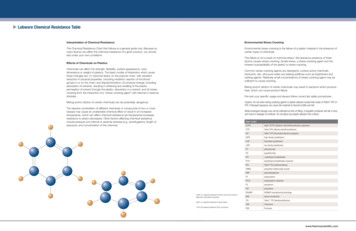
Transcription
CentrifugeLabware rifuge Chemical Resistance resInterpretation of Chemical ResistanceChemical, Concentration1-(4-Chlorophenyl)ethanone, pureFEPPPCOSS1,3-Butadiene, pureSU1,4-Dioxane, pureSM1:3 Mixture Of Nitric AndHydrochloric Acids, pureSU1-Pentanol, pureS1-Phenylethanone, pureS1-Undecanol, pureS2,2,4-Trimethylpentane, pureS2,2'-Oxybispropane, pureSPCPEPPPSFPSSILIViton PPTefzel ETFETubesPEPPEThe Chemical Resistance Chart that follows is a general guide only. Because soMSMUUUMSmanyfactorscan Maffect thechemicalresistanceof a givenproduct,youS should–U conditions.UUUSUSUUtestUunder Uyour ownUMMUUUUU PlasticsUEffectsof UChemicalsonO-ringsEnvironmental Stress CrackingChemical, Concentration1-(4-Chlorophenyl)ethanone, pureFEPPPCOSS1,3-Butadiene, pureSUUUMMMU1,4-Dioxane, pureSMUMUS2UU1:3 Mixture Of Nitric AndHydrochloric Acids, pureSUChemicalsstrength,surfaceappearance,MMcan affectM the MS2 flexibility,USMS color,MMdimensions or weight of plastics. The basic modes of interaction which causeMUMMUUUUMSMUthese changes are: (1) chemical attack on the polymer chain, with resultantS2MSMMM–SMS2S–reduction in physical properties, including oxidation; reaction of functionalU groupsU in orU on theU chain;Mand depolymerization;UU– (2) physicalUS2U–change,includingresultinginandU swellingU absorptionUUof solvents,UUU softeningUU of theS2plastic;U–theinMa solvent;M permeationUU of solventM throughUU plastic;U dissolutionSM and (3)U stressS2cracking from the interaction of a “stress cracking agent” with internal or externalMUMMUUUUMS2MUstresses.S1-Pentanol, pureS1-Phenylethanone, pureS1-Undecanol, pureSClosuresPCPEPPPSFPSSILIViton PPTefzel ETFEUUUUUUSUS2,2,4-Trimethylpentane, pureSMMMMagentsS2are detergents,US surfaceM activeSchemicals,MMCommonstresscrackingUMoils, ultra-pureMUwater andU platingU additivesUM as brightenersSM and Ulubricants,suchagents.RelativelytrationsofS2 wettingMSMMsmall concenM–S stressM crackingS2 agentS may 2'-Oxybispropane, pureSU2-Hydroxybenzaldehyde, pureSS22-Isopropoxypropane, pureS2-Propanol, pureSS2-Propanone, pureSMU Codes SResinUUECTFEM ECTFEU (ethylene-chlorotrifluoroethyleneUUU copolymer)MHalar2-Propenenitrile, pureSUETFEUSU ETFE �2-Propanol, pureS2-Propanone, pureSTheUreactivechemicalsof two orU combinationUUof differentUUUor compoundsUS2U more ultinanincreasedSUSMUUUUMS2S–temperature, which can affect chemical resistance (as temperature increases,S2USMUUU–MSS–resistance to attack decreases). Other factors affecting chemical resistanceSUSSMSSSSS2includepressureandinternalor S2externalS2stresses(e.g. centrifugation),lengthofM exposure,UUMUU chemical.UUMMUUandconcentrationof the2-Propenenitrile, pureSU3-Phenyl-2-propenal, pureS4'-Chloroacetophenone, pureS2-Methoxyethanol, pureS2-Methoxyethyl Oleate, pureSUUSUUUUUMUUMUUSMSMMUUUU2,4,6-Trinitrophenol, pureSM2-Hydroxy-1,2,3Propanetricarboxylic Acid TributylEster, pureSM2-Hydroxybenzaldehyde, pureSS22-Isopropoxypropane, pureSUU and/orU dilutionUUUU may Uresult inU reactionsS2 whichU produce–Mixingof certainchemicalsU whichU can rinitrophenol, pureMPPEThisU failureMis not aMresult ofattack.SimultaneousofMthree UU chemicalUUUM presenceMfactors causes stress cracking: tensile stress, a stress cracking agent and theUUUUUUMUS2UUinherent susceptability of the plastic to stress cracking.2-Hydroxy-1,2,3Propanetricarboxylic Acid TributylEster, pureMixing and/or dilution of certain chemicals can be potentially dangerous.PEEnvironmental stress cracking is the failure of a plastic material in the presence ofMSMMUUUMSS–certaintypesof chemicals.2-Methoxyethanol, pureSS2-Methoxyethyl Oleate, pureSS2UMMUUUUMS2MPre-test your specific usage and always follow correct lab safety procedures.UCaution: Do not store strong oxidizing agents in plastic labware except that made of Teflon FEP orS exposureM can causeMM brittle MS–PFA.MProlongedtheUmaterialUto becomeand fail. hile prolonged storage may not be intended at time of filling, a forgotten container will fail in timeUSMUUUUMS2S–and result in leakage of contents. Do not place any plastic labware into a flame.US2SUUS2U–3-Phenyl-2-propenal, pureSUFEPMUU FEPM(fluorinatedU ethylene Upropylene)UTeflonUMSS–4'-Chloroacetophenone, S–Acetaldehyde, pureSMUUMUUUUMMUUAcetaldehyde, pureSMUFLPEUMUUfluorinatedpolyethyleneUUMMUUAcetic Acid Benzyl Ester, pureSS2UMSUUUSSS2M–Acetic Acid Benzyl Ester, etic Acid Phenylmethyl Ester, pureSS2UMSUUUSSS2M–Acetic Acid Phenylmethyl Ester, pureSS2PC UMSUpolycarbonateUUSSS2M–Acetic Anhydride, pureSMUUMUUUUMSUUAcetic Anhydride, pureSMPEI UUpolyetherimideMUUUUMSUUAcetone, pureSMUUMUUUUMS2UUAcetone, pureSMPETUUpolyethyleneMU teraphthalateUUUMS2UUAcetonitrile, pureSUUSMUUUUMS2SUAcetonitrile, pureSUPETGUSpolyethyleneMU terephthalateU copolymerUUMS2SUAcetophenone, pureSMUMMUUUUMSMUAcetophenone, pureSMPFAUMTeflonM itrile, pureSUUSUUUUUUS2SUAcrylonitrile, pureSUPMMAUSpolymethylmethacrylateUUU (acrylic) UAdipic Acid, pureSSSSSSS–S2SSS–Adipic Acid, pureSSPMPSSpolymethylpenteneSSS–Alanine, pureSSSSSSSS2SSSSSAlanine, pureSSSpolypropyleneSSSS2SSSSSAllyl Alcohol, pureSSMUSMU–SSS2U–Allyl Alcohol, pureSSPP SPPCOMUpolypropyleneSM copolymerU–SSS2U–Aluminum Chloride, pureSSS2SSSSUSSSSSAluminum Chloride, pureSSPS SRESMERUSRESMERmanufacturingSMM technologyS2SSSSSAluminum Hydrate, pureSSUSSMMS2SSSSSAluminum Hydroxide, pureSSUSSMMS2SSSSSKey:S SatisfactoryS1 Satisfactory, may cause discolorationS2 Satisfactory below 26 C onlyM Marginal; may be satisfactory for use in a centrifuge depending on length of exposure and speed. Testing under operation conditions is suggested before actual run.U Unsatisfactory; not ific.comc.comAluminum Hydrate, pureSAluminum Hydroxide, pureSTeflon is a registered trademark of DuPont used under license bySANstyrene acrylonitrileNalge Nunc International CorporationKey:TFETeflon TFE (tetrafluoroethylene)SHalar Satisfactoryis a registered trademark of Solvay SolexisTMXThermanoxS1 Satisfactory, may cause discolorationPPCOreplaced polyallomerin allonlyproductsS2 hasSatisfactorybelow (PA)26 CPMXPermanoxM Marginal; may be satisfactory for use in a centrifuge depending on length of exposure and speed. Testing under operation conditions is suggested before actual run.U Unsatisfactory; not cientific.comwww.thermoscientific.com
CentrifugeLabware tinuedCentrifuge Chemical Resistance TableCentrifugewareTubesChemical, ConcentrationFEPChemical, ConcentrationPPCOPCO-ringsLabware OlefinPolymersLDPEPPPEHDPEPSFECS NumberM M.W. S202-800-7154.6020 M50EE20M1,3-Butadiene, pure1,4-Dioxane, pure106-99-0203-450-8NNF1,4-Dioxane, pure123-91-1204-661-8FGGNNNEENFEMFEGF1:3 Mixture Of Nitric And1:3 Mixture Of Acids,Nitric 200-752-11-Phenylethanone, pure98-86-2202-708-71-Undecanol,pure1-Undecanol, pure112-42-5SSU54.0988.11MUN/A1-Pentanol, pure1-Phenylethanone, pureU8007-56-5Acids, pure1-Pentanol, pureU88.15UGMUNMM120.15NMMUUUMUENEFU20UUU50 U 20GFNNFNNNS2EGGFMEGUUUUE20 M 5020E50 – SUUUM5020502050 --NN1,4-Dioxane, pure1:3 Mixture Of Nitric AndEEGEGHydrochloricAcids,pure1-Pentanol, pureEEESEEEEE1-Undecanol,pure EEEGG2,2,4-Trimethylpentane,pureEEGEEGUE– EE – EE – EEE2,2'-Oxybispropane,EEGEpure GNUEE S2 EEE2,4,6-Trinitrophenol,EGFGpure FEMEE U EEEGU50 S 20GE1,3-Butadiene, pureEMPETG FEPSEEEEE--EEEEE--1-Phenylethanone, pureSSSPCPPCOPSFPC50S20SN20 M F-S G- S N- S NUNMFG U FN U N-- S NMNN- S NMNNMUNUFNUFUNUNUNS88-89-1NUNUNNU NNU NSNE M ylicAcid Tributyl Ester, pure Acid zaldehyde,pureS77-94-1MU 360.45M201-071-2G MFEUGUGF U GUFG M 3EEGEGPropanetricarboxylic Acid opropoxypropane, pure pureS108-20-3S2203-560-6 M 102.18SNMNFMNUNNUNMNN M NEUGSEE – EEE2-Hydroxybenzaldehyde,pureEEGEG-- S NS2NN MN2-Isopropoxypropane,2-Methoxyethanol, pure pureS109-86-4UU 76.10 U203-713-7EUGEUEUEGUEUEE U EES2EUEE – EEE2-Isopropoxypropane,EEGE pureEFN S NUN2,4,6-Trinitrophenol,pure2,4,6-Trinitrophenol, pure122.12F–NGE---GUNFSANPSNFSGUPP PMMAPSF50M 20FMEO-rings50 zel ETFEConcentrationN UNN MNS540-84-1–E50UPE FEP PPETFE/PTFEUU 102.18U203-560-6MU thylpentane, purepureM50PMPPPTubesOther Labware PolymersLabware Fluoropolymers, continuedClosuresSpecialtyMaterialsHalar Tefzel FLPEETFEM GF U NN U N2,2'-Oxybispropane,pure2,2'-Oxybispropane, pureS2M 172.31S203-970-5UU 114.23U208-759-1EEClosuresLabware FluoropolymersPS PPP SILI PPCOViton 1-(4-Chlorophenyl)ethanone, pure CAS # S1-(4-Chlorophenyl)ethanone, pure99-91-21,3-Butadiene, -ME-UF50 M20NE-GUF-FNNNNEEE-FNUNU UUUU20USMSUFU--M-U-NUNUNNU-U-GUFM--UEUE- U -GSM--U-U-- U --U--GGUES50 S 20E-NNFNNNEEGNMEGU– - U - U -GM-U RESMERViton20 U 50-NGMU50PEISILITefzel PMXETFE TMX ETPPE50SS2 N S2 -UUMMS---U–50UUUNNMUE-–--–--U-–-MEF S2 E M --U-S2 -MGF S2 --M-U-UNUFNNMNGNN--NNFNEG----NSNMNNM-U-- U -M--MGF U--S-–-N U NNUNUNNUNUN- U --U-UEE S2 G-UG–-F-2-Methoxyethyl SU 340.54SEMGEUEUEGUEUGE M GES2ESEE – EEEEEEEE2-Methoxyethanol,pureG- S FNSFUNNSNMFNU-U-- U --U-MEG S2 --S-–-2-Propanol, pure Oleate, pure2-Methoxyethyl67-63-0S200-661-7 U 60.10 SS2EMEEUEUEEUE–EE M EESESEE – EEEEEE Oleate,E pureE2-MethoxyethylFN S GFS2EUGESGMNNUEUFE U EE–EMEE SEFSE–N2-Propanone, purepure2-Propanol,67-64-1S200-662-2SU 58.08 SGSNNMNS2FN S2 NSNE S EFSFSEE S2 EEEEEG2-Propanol,pureGNNN S NNSFUNNSNSNNMNS2NF S2 NFSNSEE SFNSF 03-466-5MU 53.06 UEMEEUEUFNUFUNF M NEMEUEE U EEEEEGpure E2-Propanone,G-- S NNMN U NNUNMNNU-U-- U -FUNMFNM e104-55-2S203-213-9UU 132.18SNUNGUNUNUNGSFF U GGGGEG pureE2-Propenenitrile,G-- S GUFG U FNSNUNNUNUNEUNN S2 ENSEUNEEMEUGEUEES2EUEEEEEE pureE3-Phenyl-2-propenal,-NUNUNNM-U-FUNUEE S2 --U-–-4'-Chloroacetophenone, pure200-836-8GGFGNGNUGNEGEEENG MNNNNU75-07-0E – EEEEAcetaldehyde, pureUENE U E- U -EU202-800-7UM 154.60UN U NE U EGS299-91-2SNUFUN4'-Chloroacetophenone, cetic Acid Benzyl Ester, pure140-11-4GEEEGGEGEEEEEEENNNNNNNN--FNEG---Acetic Acid Phenylmethyl Ester, pure140-11-4GEEGGEGEEEEEEENNNNNNNN--FNEG---Acetic Anhydride, , rile, none, itrile, pure107-13-1EEEFNNFNEEEEEEENNNNNNN---FNFNE-EAdipic Acid, , FNNEGENEESEGUAcetaldehyde, pureAcetic Acid Benzyl Ester, pureSSAcetic Acid Phenylmethyl Ester, pureAcetic Anhydride, pureAcetone, pureAcetonitrile, pureAcetophenone, pureAcrylonitrile, pureAdipic Acid, ��UUUUU–EEEEEESEE S EEEEUEE – EEEESEEESEE S EE S EESEE S EEAmino Acids, pureN/AN/AEEEEEEEEEEEEEEEKey:S Ammonia, FEEES1Ammonium Satisfactory,may cause discolorationChloride, pure12125-02-9235-186-453.49EEEEEEEEEEEEEEES2 Satisfactory below 26 C onlyNo damageafterdays of constanteffectandafter7 daysTestingof constantME Marginal;maybe30satisfactoryfor useexposure.in a centrifuge depending on lengthF of Someexposurespeed.underexposure.operation conditions is suggested before actual run.Little or no damage after 30 days of constant exposure.N Immediate damage may occur. Not recommended for continuous use.UG Unsatisfactory;not recommendedEEEEAllyl Alcohol, ride, pureS7446-70-0SS rate,S21645-51-2SM 78.00 U244-492-7AluminumChloride,purepureAluminum Hydroxide,S21645-51-2AluminumHydrate,Aluminum Salts,pure pureN/ASS2 78.00 S244-492-7SU N/A SAluminumHydroxide,Aluminum Trihydrate,purepureS21645-51-2SU 78.00 fic.comc.comESESGEEESEE S EESSEE S GES2SEESESEESEESESEE S2 EEMEUEG–ESESEE S GE S ESEE S GEESESGSEEMEMEGU EE S2 EESGEMEMEG S2 EEEEEEGFEG-- S -EEEEE--EEEEEEEEEG--GGGAlanine,EE pure EEEEG S EGSAllylpureE Alcohol,EEEEEG S FNSNSS EMGGG S2 GGSGNSG4'-Chloroacetophenone, pureAcetaldehyde, pureAcetic Acid Benzyl Ester, pureAcetic Acid Phenylmethyl Ester, pureAcetic Anhydride, pureAcetone, pureAcetonitrile, pureAcetophenone, pureAcrylonitrile, pureAdipic Acid, pureEESSSSSSSSSSFFNNNNNEEEAluminumEE Chloride,EEpure EAluminumpureEE Hydrate,EEEEG S FG S GEAluminumEE Hydroxide,EE pureEEG S UUUSNNNNNNEENUU
classes may cause an undesirable chemical effect or result in an increased temperature, which can affect chemical resistance (as temperature increases, resistance to attack decreases). Other factors affecting chemical resistance include pressure and internal or